Understanding Conehead Termites in Florida
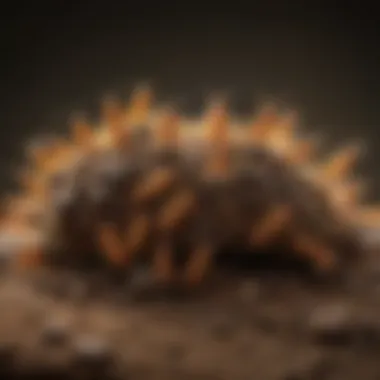
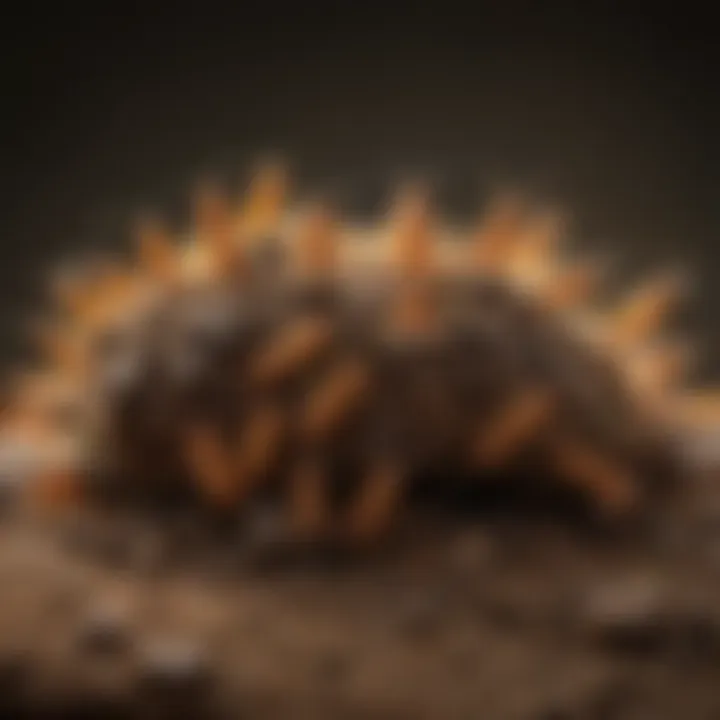
Intro
Conehead termites—when you hear the name, it might conjure up images of a sci-fi flick, but in reality, they’re a pest that's gaining traction as a considerable concern in Florida. It’s not just homeowners fretting over their prized possessions but also pest control experts and environmentally aware individuals, all scratching their heads on how to tackle these nibbling nuisances. These tiny critters can do significant damage, making early identification and innovative control strategies utterly crucial.
As we dive into the world of conehead termites, we'll cover various aspects: their biology that make them tick, the behaviors that lead to infestations, and effective strategies to manage them sustainably. Our aim is simple yet essential: to equip readers with knowledge that can protect their homes while being kind to the ecosystem.
Now, let’s roll up our sleeves and explore the ins and outs of these termites and how they can impact Florida’s landscape.
Prolusion to Conehead Termites
Conehead termites have been making a name for themselves in Florida, and it's crucial for homeowners to understand what they are up against. These creatures are more than just pests; they pose serious threats to properties, landscapes, and even local ecosystems. What makes the conehead termites particularly pressing is their ability to thrive in various environments, making them a challenge for pest control strategies. This exploration into the conehead termite situation will highlight key information, benefits of knowledge, and important considerations to navigate their increasing presence.
Defining Conehead Termites
Conehead termites, scientifically known as Nasutitermes corniger, are a type of termite that showcases distinct features such as a bulbous head. They are unique among termites due to their cone-shaped heads, which sets them apart visually. Generally, these termites are pale yellow to creamy white, and they can grow to about a quarter of an inch in length. This peculiar morphology is not merely for show; their heads are equipped with a specialized defensive mechanism, allowing them to spray a noxious substance to deter predators.
In Florida, these termites are generally found in tropical environments, which provides their necessary moisture and temperature needs. They can damage a wide variety of wood types and are known for their voracious appetites. Homeowners should remain vigilant, as conehead termites can cause significant damage if not managed properly. Understanding how they are identified is key in early detection and intervention.
Historical Context of Conehead Termites in Florida
Historically, conehead termites are relative newcomers to Florida, having been first identified in the late 20th century. Their emergence in the state aligns with changing environmental conditions and human agricultural practices that offer favorable climates for their rapid expansion. Initially documented in the Florida Keys, these pests have since spread, posing risks to both urban and rural areas alike. The increasing reports of infestations highlight a significant concern for local homeowners and pest control professionals.
Over the years, ecologists and pest control experts have been studying their habits and migration patterns. Conehead termites thrive in tropical climates, and as Florida’s climate changes, their range is likely to expand further. Throughout the years, these termites have demonstrated an ability to outcompete local termite species, underscoring their adaptability. This historical context can help homeowners appreciate the urgency of understanding these termites and staying informed about effective management practices.
"Conehead termites represent a growing threat in Florida, showcasing adaptability that raises alarms for homeowners across the state."
Arming oneself with knowledge about their characteristics, history, and potential impact is essential in face of this persistent pest. This understanding allows for more informed decisions regarding prevention and control efforts.
Biology and Behavior
Understanding the biology and behavior of conehead termites is crucial for homeowners in Florida. These termites are not just an ordinary pest; they have unique characteristics and habits that set them apart from other species. Knowledge of their biology can lead to better detection and ultimately, more effective management strategies. Understanding their behavior patterns allows homeowners to anticipate potential infestations and act before significant damage occurs.
Morphological Characteristics
Conehead termites, scientifically known as Nasutitermes corniger, have distinctive physical features that aid in recognizing them. Their bodies are typically a creamy white color, but they also have darker, more pronounced heads compared to other termites. One remarkable feature is their elongated heads which are often compared to a cone shape – hence the name "conehead." This specialized morphology is advantageous for defense; they possess a spray mechanism that allows them to shoot a defensive chemical as a means of protecting their colony.
Key features of their morphology include:
- Workers: These individuals are smaller and have a soft body, vital for foraging food.
- Soldiers: Larger than workers, with their prominent heads, their job is to defend the colony.
- Reproductive Males and Females: They can be distinguished by their wings during mating season, looking to establish new colonies.
Recognizing these traits helps in identifying infestations early and understanding the role each type plays within their social structure.
Colony Structure and Social Organization
Conehead termites exhibit a complex social structure similar to other termite species. The colony is often likened to a well-organized community, where each member has a specific role. This social organization is vital for the survival and success of the colony.
Their social hierarchy typically comprises:
- Queen: The primary reproductive member, capable of producing thousands of eggs, ensuring the colony’s growth.
- King: Accompanies the queen and is involved during the reproductive phase.
- Workers: These termites do most of the labor, including foraging for food, caring for nymphs, and maintaining the nest.
- Soldiers: Protect the colony from predators, primarily ants, using their robust jaws and chemical defenses.
The social structure allows them to function cohesively, with clear communication primarily through pheromones. Understanding this organization reveals how infestations can proliferate so quickly, stressing the need for prompt action by homeowners upon noticing signs of these pests.
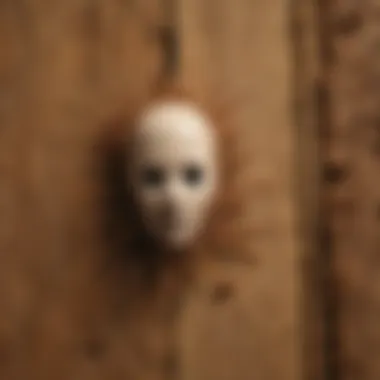

Feeding Habits and Preferences
Conehead termites have unique feeding habits distinct from other species. They primarily consume wood, but their versatility extends to various cellulose materials, including paper and some plant matter. Their preferred diet consists of:
- Decayed Wood: They particularly favor wood that has already begun to decay as it is easier to digest.
- Grass and Leaves: In the absence of wood, they can adapt and consume these materials.
- Nesting Materials: They sometimes consume parts of their nests, particularly if they require replenishment of nutrients.
The feeding habits of conehead termites can lead to rapid destruction of wooden structures in homes if not addressed. Their dining preferences result in creating extensive tunnels and galleries, which not only compromise the integrity of a structure but also cause difficulty in accurately assessing the damage.
In summary, having a solid understanding of conehead termites' biology and behavior leads to more informed prevention and control measures for homeowners. Recognizing physical traits, grasping social structures, and knowing their feeding preferences arm homeowners with the tools needed to combat these pests effectively.
"Vigilance is key; understanding conehead termites could save your home from costly repairs."
By keeping an eye out for these signs, homeowners can prevent extensive infestations and protect their property.
Identification of Conehead Termite Infestations
Identifying conehead termite infestations is crucial for homeowners in Florida. Early detection can save a great deal of time and money, as well as protect the structural integrity of homes. Being aware of the specific signs and knowing how to differentiate these pests from others in the termite family is the first step in a successful control strategy.
Signs of Infestation
One of the first signs that you might have conehead termites lurking in your home is the appearance of mud tubes. These tubes, often described as pencil-sized, are pathways created by the termites to travel safely while foraging for food. They are usually found near foundations, walls, or the base of trees. Moreover, if you come across small, discarded wings, typically near windows or light sources, that's a definite red flag. Conehead termite alates shed their wings after mating and can leave these indicators behind.
Other signs include:
- Soft spots in wood: If you tap on wooden structures and hear a hollow sound or find soft areas, it may indicate that termites have chewed through them.
- Frass (termite droppings): This can look like sawdust or tiny pellets, often found near their feeding sites. Spotting frass can help confirm the presence of termites.
- Noise from infested wood: Sometimes, you may hear a quiet, rustling sound inside walls or floors. This could be the termites munching away or moving about.
Remember: Assessing your surroundings regularly can lead to early detection and effective management.
Differentiating from Other Termite Species
While conehead termites share similarities with other species, there are key characteristics that set them apart. For instance, conehead termites have a unique, cone-shaped head, which gives them their name. This shape is distinctly visible, particularly in the soldier caste, who protect the colony.
When comparing conehead termites to other common species in Florida, such as the Eastern subterranean termites or the Formosan termite, consider the following:
- Color: Conehead termites are often lighter in color, more akin to a creamy yellowish hue, while others might be darker.
- Behavior: Coneheads tend to build more noticeable above-ground nests. If you see an active nest in your garden or under a structure, it’s likely a sign of their presence.
- Feeding patterns: Conehead termites are not as picky; they can infest a wider range of materials, including paper, wood, and even some synthetic materials, unlike some species which prefer decayed wood.
To sum it all up, recognizing the signs of infestation and understanding how to differentiate conehead termites from other pests is not just about saving your property; it’s about safeguarding the environment around you. Keeping your eyes peeled for the subtle cues and knowing whom you’re dealing with lays down the groundwork for effective pest management.
Ecological Impact of Conehead Termites
The ecological impact of conehead termites in Florida is a topic of substantial relevance, particularly as awareness of these pests grows among homeowners and ecosystem managers. Conehead termites, with their unique behaviors and feeding patterns, do not merely exist in isolation; they interact with their environments in ways that can lead to both beneficial and detrimental effects.
Understanding this impact is crucial for developing effective management strategies and for fostering a balanced ecosystem. Particularly, the role of these termites can illuminate broader environmental themes, helping to underscore the need for thoughtful pest control practices.
Role in the Ecosystem
Conehead termites play a notable role in the ecosystem. As decomposers, they break down cellulose materials, such as wood and leaf litter. This activity is essential for nutrient cycling because it allows for the transformation of dead plant matter into organic matter that enriches the soil. A healthy soil composition supports various types of plant life, benefiting the entire ecosystem.
Interestingly, these termites also serve as a food source for various native predators, which helps maintain the food web. Species such as birds, lizards, and even some amphibians depend on termites as a staple in their diets. They contribute to the dynamics of pest control or population regulation when they are consumed by such predators, thereby adding another layer of complexity to their ecological function.
Some unique details that stand out about conehead termites include:
- Their foraging habits often lead them to areas where they can access abundant organic materials.
- They initiate changes in their environment by processing large amounts of wood, which can sometimes lead to the formation of new habitats for other organisms.

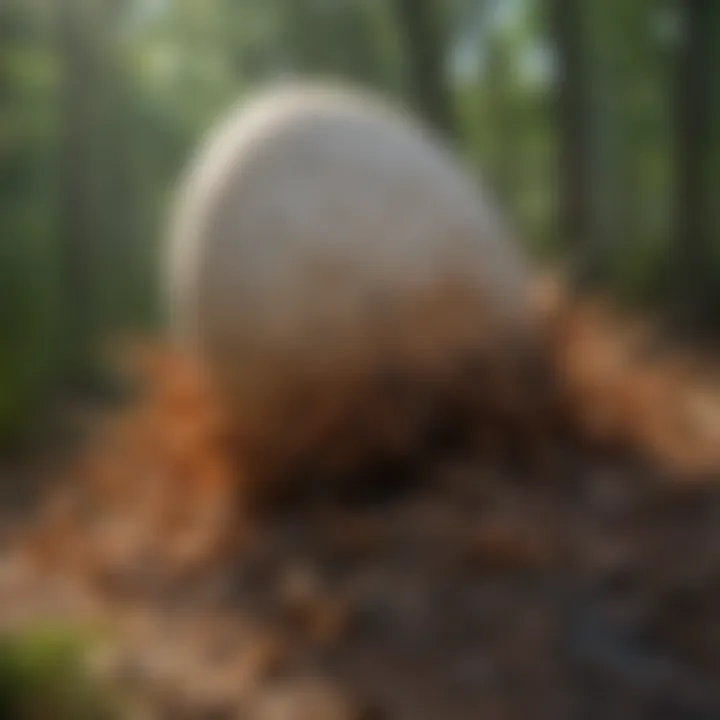
"Decomposing effectively, conehead termites assist in nourishing the earth, offering a lifeline to a multitude of flora and fauna dependent on nutrients from decaying matter."
Challenges to Native Fauna and Flora
While conehead termites play a key role in their ecosystems, they also pose certain challenges to native fauna and flora. As they can rapidly reproduce and form colonies, their populations can sometimes explode, leading to significant damage to both living plants and human structures. This, in turn, can create a ripple effect through the ecosystem.
One major concern is that conehead termites tend to favor certain types of trees, often targeting healthy specimens. This can lead to diminished vegetation density in local habitats, which could in turn affect other species that depend on those plants for shelter and food. For example:
- Loss of habitat for birds and small mammals: When tree populations dwindle, so too does the availability of nesting sites and food sources.
- Decreased biodiversity: If conehead termites disproportionately affect particular tree species, this could lead to monocultures where many organisms, including insects and birds, struggle to thrive.
Another important point to mention is how they may introduce diseases or pathogens that can adversely impact other plant species. Overall, the ecological impact of conehead termites in Florida serves as a double-edged sword - beneficial under certain circumstances but potentially harmful when it affects groups of native plants or disrupts local food chains.
By understanding these intricate relationships, homeowners and pest management professionals can approach conehead termite infestations with a balanced perspective, aiming for solutions that maintain ecological integrity while still addressing pest concerns.
Geographical Distribution in Florida
Understanding the geographical distribution of conehead termites in Florida is crucial for homeowners, pest management professionals, and environmentalists alike. These termites are invasive species impacting both residential properties and the natural ecosystem. By knowing where these pests thrive, one can better prevent infestations and mitigate their effects.
Regions Affected by Conehead Termite Infestations
Conehead termites are particularly prevalent in the southern regions of Florida. Areas like Miami-Dade County, Monroe County, and the Florida Keys have shown significant occurrences. The warm, humid climate of these areas creates ideal conditions for conehead termites to flourish.
This tendency to populate certain regions can be attributed to several factors:
- Climate Suitability: The warm temperatures and moisture levels in Southern Florida play a pivotal role in the survival and reproduction of these pests.
- Urban Development: Rapid urbanization often results in soil disturbances. In turn, this creates engaged habitats for conehead termites.
- Vegetation: They are often drawn to certain trees and types of mulch commonly used in landscaping across these regions.
As a homeowner, it’s vital to be especially alert if you live in these identified regions, taking proactive measures to protect your property.
Trends in Population Growth
The growth of conehead termite populations has been alarming over recent years. Reports reflect not just an increase in their numbers but also a wider distribution across previously unaffected areas. Some noteworthy trends include:
- Expansion Beyond Initial Regions: Initially concentrated in urban areas, these termites are now found in suburban and even some rural locations. Their ability to adapt has led to a notable spread, prompting concerns about potential future infestations far from established hot spots.
- Seasonal Variability: Population surges are often seen with seasonal changes, particularly in the warmer months. This is when their reproductive systems become most active, enabling colonies to expand rapidly.
- Increased Human Awareness: While populations grow, awareness among homeowners is also on the rise. Community education efforts have intensified, making it easier for people to recognize early signs of infestations and take appropriate actions to manage their risk.
The continuous increase in conehead termite populations underscores the necessity for vigilance and effective pest management strategies, especially in affected regions.
In summary, the geographical distribution and the observed trends in population growth offer vital insight into the behavior of conehead termites in Florida. By understanding where these pests are most prevalent and how their populations are changing, individuals and communities can better protect their homes and ecosystems.
Pest Control Strategies
Pest control strategies are pivotal in managing conehead termites effectively. With these termites posing a significant threat to homes and landscapes in Florida, homeowners need to understand various approaches for combating infestations. Implementing effective pest control strategies not only safeguards individual properties but also plays a vital role in protecting local ecosystems.
A comprehensive pest control plan often combines preventative measures, chemical treatments, and eco-friendly solutions. This multifaceted approach maximizes efficacy while minimizing environmental impact. Homeowners who grasp these concepts are better equipped to manage infestations before they escalate.
Preventive Measures for Homeowners
Preventive measures serve as the first line of defense against conehead termites. By taking proactive steps, homeowners can significantly reduce the risk of infestation. Some practical strategies include:
- Regular Inspections: Routine checks around the home can help detect early signs of termite activity, such as mud tubes or damaged wood. These inspections are crucial, especially in regions known for termite issues.
- Moisture Control: Conehead termites thrive in damp environments. Ensuring proper drainage away from the foundation and fixing any leaks can deter these pests.
- Proper Landscaping: Keeping plants and mulch away from the house's foundation can prevent termites from making their way indoors. Trim back tree branches and bushes that touch the home’s exterior to remove potential bridges.
- Seal Entry Points: Cracks and crevices in the foundation should be sealed to block termite access. Simple caulking can go a long way.
By implementing these habits, homeowners create an environment that is less hospitable to conehead termites, reinforcing the integrity of their living spaces.
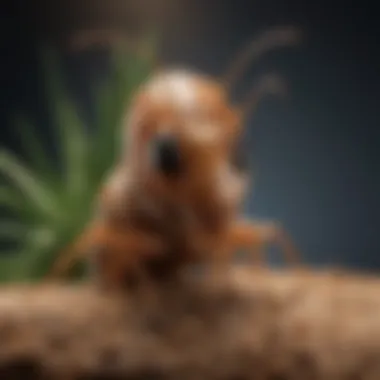
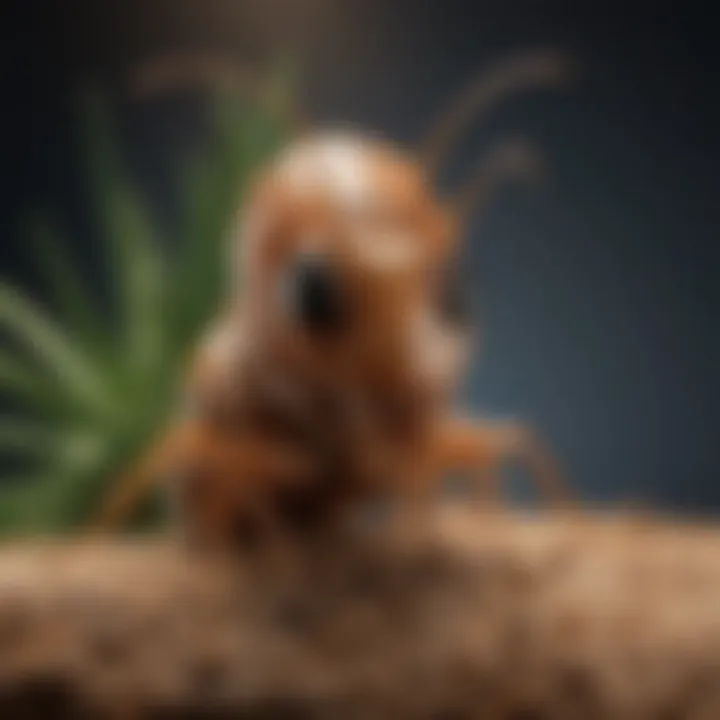
Chemical Control Methods
When prevention falls short, chemical control methods may be necessary to address termite infestations. It’s worth noting that chemical treatments should be carried out by licensed pest control professionals to ensure safety and effectiveness. Common methods include:
- Termiticides: These are specialized pesticides designed to eradicate termites. They can be applied to treat the soil around the foundation, creating a barrier that kills workers and prevents them from reaching the home.
- Baiting Systems: These systems involve placing bait stations around the property. The bait contains substances that attract termites, allowing them to carry the lethal agent back to the colony, ultimately killing off the entire group.
- Foaming Agents: In some cases, a foam application may be used for targeted treatment in tight spaces where traditional sprays can’t reach.
While these chemical methods can be effective, they must be used judiciously, as improper use can harm beneficial insects and other wildlife.
Eco-Friendly Pest Management Solutions
With growing concerns about environmental sustainability, many homeowners are turning to eco-friendly pest management solutions. These approaches are not only better for the planet but can also be effective against conehead termites. Some options include:
- Nematodes: These microscopic roundworms are natural predators to termites. Introducing beneficial nematodes to infested areas can help reduce termite populations without resorting to harsh chemicals.
- Boric Acid: Boric acid is a natural insecticide. When applied strategically, it disrupts the termite's digestive system and can help control populations over time.
- Essential Oils: Some essential oils have been known to repel or kill termites. Oils like clove and neem can be used in a diluted form to treat affected areas.
These eco-friendly methods emphasize the importance of balanced pest management, aligning with sustainable practices and promoting healthier living environments.
"An ounce of prevention is worth a pound of cure."
By integrating pest control strategies into the home maintenance routine, homeowners can better protect their properties from the relentless encroachment of conehead termites.
Best Practices for Sustainable Pest Management
Sustainable pest management is not just a trend; it’s becoming essential, especially for those facing the challenge of conehead termites in Florida. These pests are hardy and adaptable, making control a daunting task. However, integrating sustainable methods can significantly reduce their impact while reinforcing the health of our local ecosystems. This part of the article unpacks key practices that play a role in effectively managing these termites without compromising the environment.
Integrated Pest Management (IPM) Approach
The Integrated Pest Management (IPM) approach is rooted in the philosophy that prevention is better than cure. Rather than relying solely on chemical solutions, IPM incorporates a variety of tactics. For homeowners dealing with conehead termites, implementing IPM might involve:
- Monitoring and Identification: Regular checks around your home can help spot potential infestations early. Using traps can help you catch a glimpse of these pests in action, providing a clearer picture of their activity.
- Habitat Modification: Termites thrive in moist environments. Keeping gutters clean and ensuring proper drainage can significantly reduce the risk of infestations.
- Cultural Practices: Choosing resistant plant species and understanding the natural enemies of termites can help maintain a balanced ecosystem. Making informed choices about landscaping can also lower the appeal of your property to pests.
- Mechanical Controls: Physical barriers like metal mesh or sand barriers can deter termites from entering your home. This is a low-impact method that aligns well with sustainable practices.
The effectiveness of IPM lies in its holistic approach, combining observation, preventive measures, and targeted intervention. It embraces both traditional knowledge and modern technology.
Community Awareness and Involvement
Pest management efforts can significantly improve when the community gets involved. Raising awareness about the nature of conehead termites can foster better habits and proactive strategies among your neighbors. Some effective ways to encourage community participation include:
- Workshops and Events: Hosting local workshops focused on termite identification and prevention techniques can empower residents with knowledge. Engaging professionals to share insights can help demystify these pests.
- Sharing Resources: Create platforms, whether online or community boards, where residents can share their experiences and resources for combating conehead termites. Platforms like Reddit and Facebook can facilitate discussions and connection among homeowners.
- Local Clean-Up Initiatives: Organizing clean-up days in green spaces can help eliminate potential termite habitats. These initiatives not only raise awareness but also build community bonds while protecting the local environment.
"In addressing pest challenges, our greatest ally is the community. Collective knowledge and action can lead us toward smarter, more sustainable solutions."
By engaging the community, homeowners can significantly enhance their defenses against conehead termites while also improving environmental health. The key to successful pest management is striking a balance between individual efforts and collaborative community action.
Finale
Addressing the growing concern of conehead termites is crucial, not just for homeowners but for anyone invested in Florida’s ecosystems. This article has provided a detailed analysis of these pests, articulating their biology, ecological impact, and management strategies. It’s imperative to appreciate the full scope of this topic, as it extends beyond simple pest control; it encroaches on maintaining Florida's unique natural landscapes.
Summarizing Key Points
To encapsulate the insights presented:
- Identification is essential: Recognizing the signs of infestation early can save headaches later. Common indicators include mud tubes and discarded wings.
- Ecosystem role: Conehead termites can disrupt native species and contribute to environmental degradation. This calls for awareness and proactive measures from all community members.
- Pest control methods: Homeowners now have multiple approaches to manage these termites—ranging from traditional chemical methods to more eco-friendly alternatives like biological control.
It’s essential for residents to internalize these points not only to protect their homes but to play an active role in conserving the environment.
The Importance of Vigilance in Pest Management
Being vigilant in pest management cannot be stressed enough. Conehead termites, if left unchecked, can wreak havoc on properties and natural flora. Regular inspections and maintenance checks are paramount. For homeowners, this means keeping an eye on areas that are prone to moisture, as these create ideal conditions for termites. In addition, participating in local community programs about pest awareness will enhance overall neighborhood resilience against infestations.
"An ounce of prevention is worth a pound of cure.”
Moreover, collaborating with pest control experts frequently can provide insights and tools that might not be apparent to untrained eyes. By fostering a community-wide approach and prioritizing education on termite behavior, Florida residents can build a robust line of defense against these invasive pests. Staying informed and proactive is truly the name of the game here.



